

Back to Our Egypt Trip
This was our first taste of the archaeological sites, and it was a doozie!! Karnak is magnificient!! The size and grandeur can not be captured on film. The main entrance to the 1st pylon, is lined with ram-headed sphinxes on both sides. It was built with an east/west orientation. Inside the vestibule were 15 square pillars and 14 round columns. The site is gigantic!! The main sanctuary is devoted to Amun. The Temple of Mut (Amun's wife) lies to the South. Khonsu's (the son of Mut and Amun) Temple is inside the main complex. Montu, Ptah, and Osiris also had temples inside the sacred area.
Some pharoahs, and/or kings, tore down elements of the preceding dynasties and included them, inside their own pylons.
 As
we approach Karnak, from the parking area. This first pylon is thought to have
been built by Nectanabo I (c.380-c.362 BC)
As
we approach Karnak, from the parking area. This first pylon is thought to have
been built by Nectanabo I (c.380-c.362 BC)

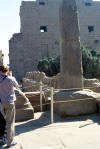
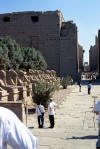 Ram-headed
sphinxes line both sides of the entrance. Some bear the names of Ramesses II and
Pinedjem but were probably built by Amenhotep III (c.1390-c.1352BC)or Horemhab
(c.1323-1295 BC). It was not unusual for one person to build a structure only to
have successors claim it as their own. Ramesses II did this a lot.
Ram-headed
sphinxes line both sides of the entrance. Some bear the names of Ramesses II and
Pinedjem but were probably built by Amenhotep III (c.1390-c.1352BC)or Horemhab
(c.1323-1295 BC). It was not unusual for one person to build a structure only to
have successors claim it as their own. Ramesses II did this a lot.
 On
the opposite side of this courtyard were 3 chambers thought to have contained
sacred boats.
On
the opposite side of this courtyard were 3 chambers thought to have contained
sacred boats.
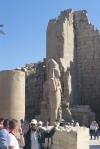

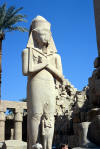 The statue of Ramesses II, usurped by Pinedjem.
The statue of Ramesses II, usurped by Pinedjem.
Here are a few of the papyrus-topped columns, with the papyrus, in the closed position. The Hypostyle Hall had a massive sandstone block roof supported by 122 closed papyrus-bud columns and 12 open papyrus-bud columns. Tiny windows let small amounts of light into the inner sanctum. Many of the carvings, done by Seti I, were delicate and low relief while Ramesses II (Seti's son) carved his much deeper, to protect them from being defaced. This entire area would never have been seen by the public. Only the high priests were allowed inside. In fact, most of the public had to be "purified" before they were even allowed into some of the outer areas.

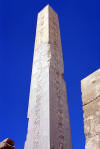
 The
granite obelisks are gigantic and the colors, under the lintels, are
beautiful.
The
granite obelisks are gigantic and the colors, under the lintels, are
beautiful.


 Light could not hit the undersides of the lintels thus,
preserving their colors.
Light could not hit the undersides of the lintels thus,
preserving their colors.
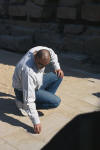 Amr, describes the layout of the site. Guides are not allowed
into certain areas, of some sites, because it's thought that they slow down the
movement of the crowds. We arrived in a 100 bus caravan. Most buses carried
around 50 occupants. That means that nearly 5,000 people would arrive at the
site at about the same time. Amr always seemed to get us there near the front of
the line. We would arrive and turn back to see thousands of visitors coming
toward us. it's good to arrive first!
Amr, describes the layout of the site. Guides are not allowed
into certain areas, of some sites, because it's thought that they slow down the
movement of the crowds. We arrived in a 100 bus caravan. Most buses carried
around 50 occupants. That means that nearly 5,000 people would arrive at the
site at about the same time. Amr always seemed to get us there near the front of
the line. We would arrive and turn back to see thousands of visitors coming
toward us. it's good to arrive first!
 Some beautiful color still remains on some ceilings
Some beautiful color still remains on some ceilings
 and even on some walls.
and even on some walls.
 This picture shows the priests carrying the sacred boat. The
high priests can be seen near the center. They are wearing jaguar skins.
This picture shows the priests carrying the sacred boat. The
high priests can be seen near the center. They are wearing jaguar skins.
 The sacred lake, where the sacred boats were kept. There is an
underground channel to the Nile so the water in the lake is the same level as
that of the Nile. Notice, the pylon being reconstructed, in the background.
The sacred lake, where the sacred boats were kept. There is an
underground channel to the Nile so the water in the lake is the same level as
that of the Nile. Notice, the pylon being reconstructed, in the background.